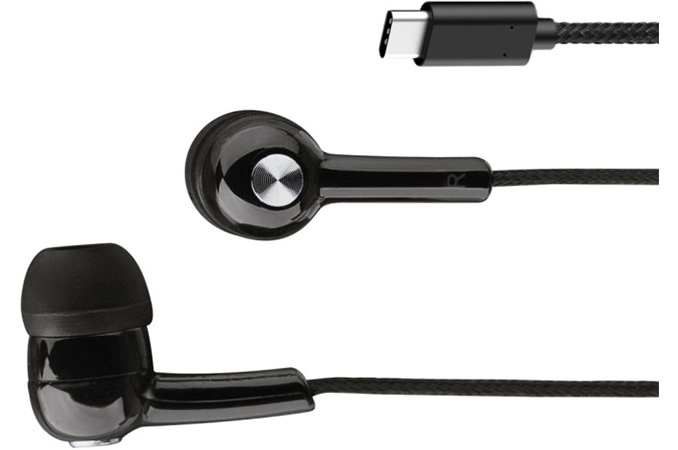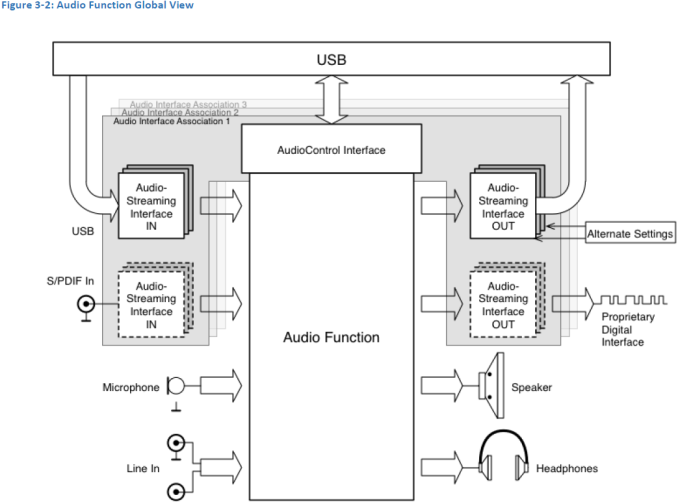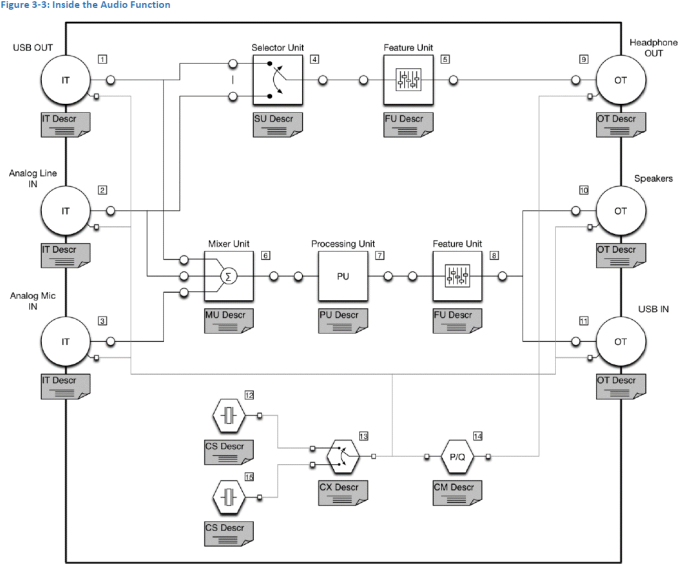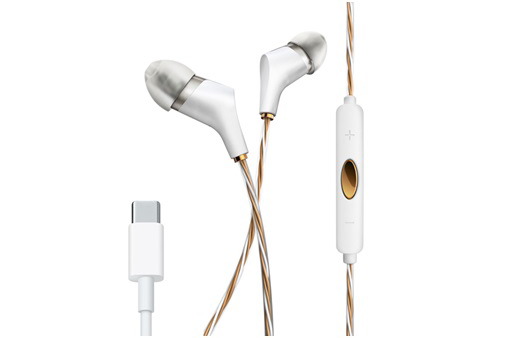USB-IF Publishes Audio over USB Type-C Specifications
by Anton Shilov on September 30, 2016 12:00 PM EST- Posted in
- Mobile
- USB-C
- USB-C Digital Audio

The USB Implementers Forum this week published the USB Audio Device Class 3.0 specification, which standardizes audio over USB Type-C interface. The new spec enables hardware makers to eliminate traditional 3.5mm mini-jacks from their devices and use USB-C ports to connect headsets and other audio equipment. Makers of peripherals can also build their audio solutions, which use USB-C instead of traditional analog connectors. Developers of the standard hope that elimination of mini-jacks will help to make devices slimmer, smarter and less power hungry.
The industry, led by Intel and some other companies, has been mulling about replacing the traditional 3.5mm mini-jack connector for some time now. The main motives for replacement were necessity to simplify internal architecture of devices by removing analog and some audio processing components from the inside (which leads to further miniaturization), minimize the number of external connectors, improve power management as well as to add smart features to headsets and other audio equipment. We discussed USB Type-C Audio Technology briefly earlier this year and mentioned that this is not the first time that the industry has tried to use USB instead of the good-old mini-jack. The important difference between contemporary initiative and attempts in the past is the fact that today the primary goal is to replace the 3.5mm jack in portable devices.
As reported, the USB Audio Device Class 3.0 specification supports both analog and digital audio. Analog audio is easy to implement and it does not impact data transfers and other functionality of USB-C cables since it uses the two secondary bus (SBU) pins. Some device makers may find the analog audio feature of the standard to be a relatively simple way to add certain smart capabilities to their headsets without major redesign of hosts. While analog USB-C audio will not help to shrink dimensions of portables, it could be particularly useful for non-mobile devices, where miniaturization is not crucial, but where port space is at a premium or where additional features either make sense (infotainment, sport equipment, etc.) or are fundamental (VR HMDs).
The USB ADC 3.0 defines minimum interoperability across analog and digital devices in order to avoid confusion of end-users because of incompatibility. In fact, all ADC 3.0-compliant hosts should support the so-called headset adapter devices, which allow to connect analog headsets to USB-C. However, digital audio is one of the primary reasons why companies like Intel wanted to develop the USB-C audio tech in the first place, hence, expect them to promote it.
According to the USB ADC 3.0 standard, digital USB-C headphones will feature special multi-function processing units (MPUs), which will, to a large degree, define the feature set and quality of headsets. The MPUs will handle host and sink synchronization (this is a key challenge for digital USB audio), digital-to-analog conversion, low-latency active noise cancellation, acoustic echo canceling, equalization, microphone automatic gain control, volume control and others. Such chips will also contain programmable amplifiers and pre-amplifiers, which are currently located inside devices. Besides, USB ADC 3.0-compatible MPUs will also support USB Audio Type-III and Type-IV formats (the latest compressed formats), but will retain compatibility with formats supported by ADC 1.0 and 2.0. Finally, among the mandated things set to be supported by USB-C Audio devices are new Power Domains (allows devices to put certain domains in sleep mode when not in use) as well as BADD (basic audio device definition) 3.0 features for saving power and simplified discovery and management of various audio equipment (each type of devices has its own BADD profile).
Over the past few months, Conexant has introduced three USB-C Audio MPUs (1, 2) for headsets, docking stations and other equipment. Assuming that these chips are compliant with the USB ADC 3.0 specs from a hardware standpoint, and the software is ready, actual devices featuring USB-C Audio could arrive in the coming months. Pricing of the first USB ADC 3.0-compliant MPUs is unknown, but in general MPU ICs do not cost too much. Moreover, as developers adopt smaller process technologies and a larger number of such chips hit the market, their prices are going to decline. In the end, it will be interesting to see where digital headphone prices end up. The MPUs will definitely add to the total bill of materials for a set of headphones, but at the same time they add new functionality as well, so the big question is how manufacturers then factor all of that into device pricing.
A number of companies, including Apple and LeEco, have already introduced smartphones that do not use traditional mini-jacks, and Google added support for USB DAC devices to Android over a year ago. The finalization of the USB ADC 3.0 spec, introduction of USB-C audio ICs, as well as design decisions of smartphone makers demonstrate that the industry is trying to eliminate 3.5mm jacks from mobile devices. The big question is whether the rest of the industry plans to do the same. It is true that portables are primary devices for music listening for many people. However, there are tens of applications which still rely on analog connectors, and hundreds of millions of people who use them either to consume or create content. To eradicate 3.5mm jacks completely, USB-C Audio promoters will have to work with thousands of vendors and this takes time. Consequently, it is too early to say that this is the end for the good-old mini-jack.
Images by Conexant, USB IF.
Source: USB IF













93 Comments
View All Comments
Zoomer - Saturday, October 1, 2016 - link
Plenty of receivers that take HDMI in and have good amps. Your point?Nexing - Saturday, October 1, 2016 - link
Amazing how nobody has yet put out the obviously hidden argument behind this move...I seem to recall it was said on the first discussion. It is the Audio Content Industry that is behind this.
They want to insert a final control key to the music/audio that is delivered from the new gear.
Simply as that.
This is part of a long going struggle and they are now influencing crucial hardware manufacturers (Apple, Intel) in order to set the landscape for their future control actions.
In terms of BiggerInside's above recount of the mentioned arguments, I agree it is the last one that somehow stands: "we want to remove the headphone jack so our headphones can connect over USB and have new digital features!".
Part of those digital features is controlling that the content is copyrighted by future schemes to be implemented... This way they may limit play of certain files right on your own device, no matter its source.
Such is the holy grail big labels are trying to attain.
Zoomer - Saturday, October 1, 2016 - link
Rest assured no one copies music through the headphone jack. Their DRM solution was already full of holes that moving to selling unencrypted MP3s or even FLACs made no difference in piracy rates.iranterres - Saturday, October 1, 2016 - link
Brace yourselves for an era of crappy audio output!!! LOLsharath.naik - Sunday, October 2, 2016 - link
This move is going to fail for one simple reason. USB C is not sturdy enough to hold a wired headphone. Headphone jack needs to stay in place when it is plugged in even when moving with all the tug and pull . USB C simply does not provide that.If the technology is unfriendly compared to what it is replacing it simply fails. This will too. Apple just wants to make more money nothing more.
lagittaja - Sunday, October 2, 2016 - link
The USB specification text is a little bit heavy so excuse me if this is said in the specifications but..What does this mean for existing USB Type C devices?
Can the USB ADC 3.0 be "enabled" on a device with a "simple" firmware update or will it need new hardware so old devices wouldn't be able to use it?
Icehawk - Sunday, October 2, 2016 - link
Staring at my phone I don't see much space saved externally by going just lightning - how much of a difference is there from the board side?If Apple went USB-C, which they will never do, it would suck slightly less.
Not that my phone is for serious listening but I own a fair amount of headphones, some fairly high-end, and there is no way I am going digital with them for a long time - somehow I doubt we will see this on AVRs anytime soon. I also seriously doubt in the near term that good quality headphones (HD600, Grado 325, etc) will be going USB or lightning as well. I could care less what Beats or Bose does.
External DACs and amps for headphones suck IMO, removing portability isn't the goal of mobile audio.
lagittaja - Sunday, October 2, 2016 - link
How much of a space saving is it?You should take a look at the teardowns. It's not much.
https://www.ifixit.com/Teardown/iPhone+7+Teardown/...
https://www.ifixit.com/Teardown/iPhone+6s+Teardown...
Now there's a "barometric vent" in the headphone jack's place. Basically a plastic doohickey which allows to equalize the internal pressure to that of the atmosphere: accurate altimeter with the watertight seals.
Impulses - Sunday, October 2, 2016 - link
At the high end I imagine people will just go down one of two paths... Either they actually want those external components in an additional device because they're hardcore about their audio and/or they're highly mobile (if I traveled for work I'd probably own a Leckerton DAC/amp since it features optical AND USB in)...OR they just keep on keeping on with an active adapter like what Apple is shipping (semi active? not sure what the consensus on it is yet), or go wireless. Active dongles with their own little DAC/amp inside are probably no better than a Bluetooth receiver dongle tbh, and the latter frees up the phone even it doesn't completely eliminate wires.
I've been doing the latter to an extent for a while now (Sony MW600), tho I'm not walking around outside with high end open cans on my head (my HD600 are strictly for my desk/Ikea lounger)... I don't feel like it's holding back my OPPO PM3 or V-Moda XS when I'm on the go. I do switch back to wired to conserve battery tho.
The mass market is just going wireless regardless, nobody spending any kind of decent money on Beats or anything better will care in a couple years... Cheapskates and people that don't need anything more than a $5 headset are ironically the most impacted.
I think whether laptops and tablets adopt this quickly might determine whether the backlash wins out over market interests... If it remains something only phones are forcing people are gonna be suitably PO'd.
SeleniumGlow - Monday, October 3, 2016 - link
I was under the impression that wired headsets consume as much battery as Bluetooth v4. I was also trying to search for battery life benchmarks between wired and wireless headsets, but couldn't find anything convincing.